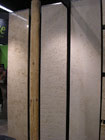
Vereinigte Marmorwerke (V.M.) Kaldorf GmbH has five quarries for Jura limestone in the heart of Germany’s stoneworking region, three of which are currently active.
Based in the center of Germany’s Jura limestone region, Vereinigte Marmorwerke (V.M.) Kaldorf GmbH was founded in 1971 as a supplier of local stone materials. Today, the company - whose name means “United Stoneworks” in English - operates multiple quarries and stoneworking facilities, and it supplies Jura limestone to markets around the world.
V.M. Kaldorf is located in the village of Kaldorf - part of the city of Titting - an area plentiful in Jura limestone resources. The company has a total of five quarry sites in the region, three of which are active. V.M. Kaldorf has a total of 130 employees, including 17 in the quarries and 14 in the sales/administration office. The remainder of the company’s employees work in production.
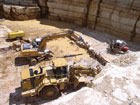
The Jura limestone quarries in the region have multiple layers, and they contain a number of different stone varieties.
Quarrying operations
The Jura limestone quarries in the region have multiple layers, and they contain a number of different stone varieties. Typically, the type of material that is yielded depends on which layer is being worked. Layers 1 through 7 yield gray-blue varieties; layers 8 through 16 are light beige and well-suited for products such as tiles and stairways; and layers 17 through 25 are dark beige and well-suited for elements such as facades and monuments.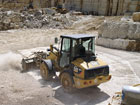
When extracting material, the top of the layer to be quarried is first brushed using a specially equipped Caterpillar 907 rig.
The breakdown of materials among the different layers is similar from quarry to quarry, explained Lorenz Branner, who directs quarry operations at V.M. Kaldorf. Of the three quarries currently in operation by V.M. Kaldorf, the company is working different levels in each quarry. Working multiple levels ensures that V.M. Kaldorf will have steady production and inventory of all materials. Blocks have a typical size of 1.3 x 2.5 x 1.5 meters, but the company is able to produce blocks as large as 3 meters in size. The thickness of the block is based on the natural characteristics of the quarry, and this can change depending on the layer. Block production is carefully organized according to the quarry layer, and the blocks are never mixed. Armed with cans of spray paint, Branner and others quickly identify blocks as they are produced.
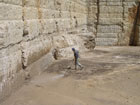
After brushing, the surface is then power washed. This allows the quarry workers to see the natural pattern of the material so they can drill to their best advantage. It is also a quality-control step to see the exact color of the layer.
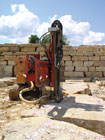
V.M. Kaldorf has made a range of financial investments in its quarrying equipment, including new drilling rigs.
As quarrying within a quarry site progresses, experience is an important factor in determining where to move. “You develop a sense of where you need to go,” Branner said. “It is always important to study the quarry walls and determine where to go. We prefer a wider quarry, where there is room to operate.”
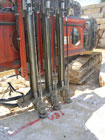
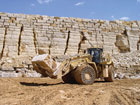
Large-scale loaders from Catepillar are used to move blocks around the quarry.
Production
V.M. Kaldorf has several stoneworking facilities in place, and all are located near the quarry sites.Blocks are processed on a variety of sawing equipment, depending on the finished product. These include gangsaws and a Bidesimpianti diamond wire saw for slab production. The slabs are then processed on slab polishing lines from Simec of Italy.
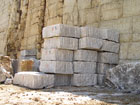
Block production is carefully organized according to the quarry layer, and they are labeled at the site.
In the cut-to-size area, equipment includes bridge saws from Löffler of Germany and an automated edging machine, as well as a range of hand tools.
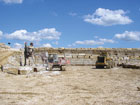
Of the three quarries currently in operation by V.M. Kaldorf, the company is working different levels in each quarry.
Water treatment is a priority in V.M. Kaldorf’s production, and the company has a system in place to separate the slurry from the wastewater. The slurry is then carted away, while the water is reused in the factories.

Blocks are processed on a variety of sawing equipment, depending on the finished product. Gangsaws are used for slab production.
In all areas of production, quality-control is a key element of the process, and materials are carefully inspected before being packaged for shipment.
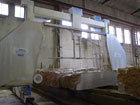
V.M. Kaldorf also operates a Bidesimpianti diamond wire saw from Italy.
Approximately 50% of the stone sold by V.M. Kaldorf is tile and slab production; 40% is cut-to-size work such as interior and exterior facades, custom-produced tiles and countertops; and 10% is blocks and landscape materials.
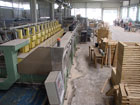
Raw slabs are processed on slab polishing lines from Simec of Italy.
Sales and marketing
A total of 70% of V.M. Kaldorf’s production is sold within Germany, and 30% is exported. Hungary is a key export market for the company, and China is strong for block sales. In the U.S., the company sells through representatives such as TriStone & Tile, Inc. of Nuys, CA, and Facings of America in Phoenix, AZ.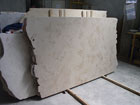
Full-sized slabs of Jura limestone are available in all material varieties.
According to Hubert Kuenzl, who works in the company’s commercial department, sales have been steadily improving over the course of 2009.
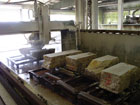
For tile production, blocks are first cut on a large-diameter circular saw, and then the smaller blocks are processed on a German-made blockcutter, which produces strips to deliver to the tile line.
Additional Photos

A modern tile line from Simec is in place in the factory, and it includes robotic elements for material loading and unloading.
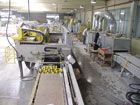
In the cut-to-size facility, equipment includes bridge saws from Löffler of Germany as well as a range of hand tools.
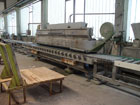
A Comandulli Edilux automated edger is also in place in the cut-to-size facility.
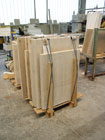
In all areas of production, quality-control is a key element of the process, and materials are carefully inspected before being packaged for shipment.
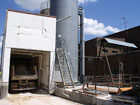
Water treatment is a priority in V.M. Kaldorf’s production, and the company has a system in place to separate the slurry from the wastewater. The slurry is then carted away, while the water is reused in the factories.

At the time of Stone World’s visit, work was ongoing for the new museum in Liverpool, England, which has a range of custom-cut Jura limestone from V.M. Kaldorf. The museum is expected to open in 2010.
photos courtesy of National Museums Liverpool
photos courtesy of National Museums Liverpool
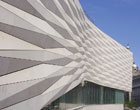
photos courtesy of National Museums Liverpool
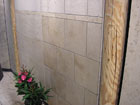
A variety of surface finishes are available for all products, including polished, bushhammered, brushed, sandblasted, slightly sandblasted, “tooth chiseled” and combinations of the various textures.

